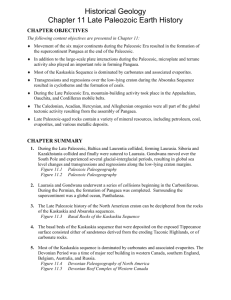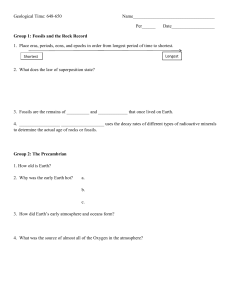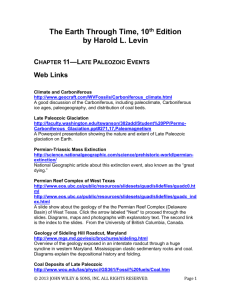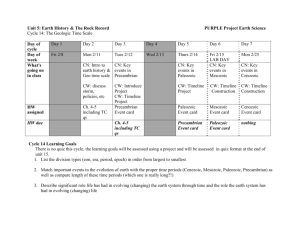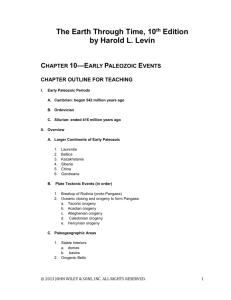CHAPTER 11 - GeoClassroom
advertisement
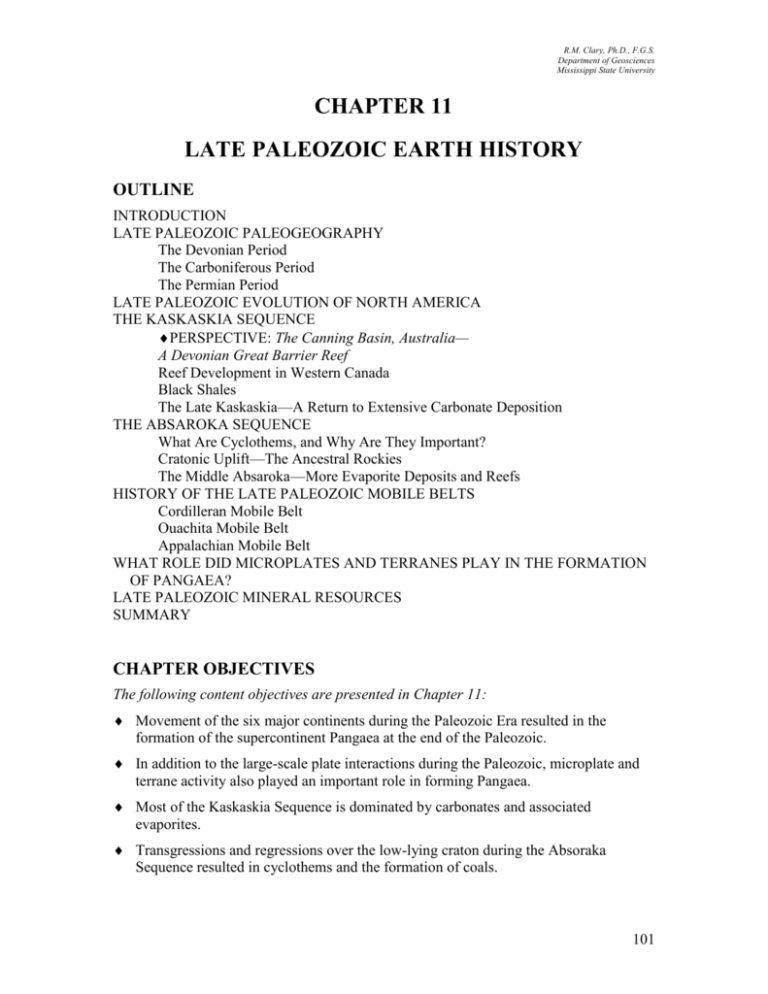
R.M. Clary, Ph.D., F.G.S. Department of Geosciences Mississippi State University CHAPTER 11 LATE PALEOZOIC EARTH HISTORY OUTLINE INTRODUCTION LATE PALEOZOIC PALEOGEOGRAPHY The Devonian Period The Carboniferous Period The Permian Period LATE PALEOZOIC EVOLUTION OF NORTH AMERICA THE KASKASKIA SEQUENCE PERSPECTIVE: The Canning Basin, Australia— A Devonian Great Barrier Reef Reef Development in Western Canada Black Shales The Late Kaskaskia—A Return to Extensive Carbonate Deposition THE ABSAROKA SEQUENCE What Are Cyclothems, and Why Are They Important? Cratonic Uplift—The Ancestral Rockies The Middle Absaroka—More Evaporite Deposits and Reefs HISTORY OF THE LATE PALEOZOIC MOBILE BELTS Cordilleran Mobile Belt Ouachita Mobile Belt Appalachian Mobile Belt WHAT ROLE DID MICROPLATES AND TERRANES PLAY IN THE FORMATION OF PANGAEA? LATE PALEOZOIC MINERAL RESOURCES SUMMARY CHAPTER OBJECTIVES The following content objectives are presented in Chapter 11: Movement of the six major continents during the Paleozoic Era resulted in the formation of the supercontinent Pangaea at the end of the Paleozoic. In addition to the large-scale plate interactions during the Paleozoic, microplate and terrane activity also played an important role in forming Pangaea. Most of the Kaskaskia Sequence is dominated by carbonates and associated evaporites. Transgressions and regressions over the low-lying craton during the Absoraka Sequence resulted in cyclothems and the formation of coals. 101 R.M. Clary, Ph.D., F.G.S. Department of Geosciences Mississippi State University During the Late Paleozoic Era, mountain-building activity took place in the Appalachian, Oauchita, and Cordilleran mobile belts. The Caledonian, Acadian, Hercynian, and Alleghenian orogenies were all part of the global tectonic activity resulting from the assembly of Pangaea. Late Paleozoic-aged rocks contain a variety of mineral resources, including petroleum, coal, evaporites, and various metallic deposits. LEARNING OBJECTIVES To exhibit mastery of this chapter, students should be able to demonstrate comprehension of the following: the global geography and climate for the Late Paleozoic the Kaskaskia sequence in North America reef development in the Late Paleozoic the location and possible genesis of black shales the Absaroka sequence in North America the formation, location, and importance of cyclothems in the geologic record the formation of the Ancestral Rockies the history of the Late Paleozoic mobile belts and their relationship to global geography and the assembly of Pangaea the types and occurrences of Late Paleozoic mineral deposits, particularly coal CHAPTER SUMMARY 1. During the Late Paleozoic, Baltica and Laurentia collided, forming Laurasia. Siberia and Kazakhstania collided and finally were sutured to Laurasia. Gondwana moved over the South Pole and experienced several glacial-interglacial periods, resulting in global sea level changes and transgressions and regressions along the low-lying craton margins. Figure 11.1 Paleozoic Paleogeography Figure 11.2 Paleozoic Paleogeography 2. Laurasia and Gondwana underwent a series of collisions beginning in the Carboniferous. During the Permian, the formation of Pangaea was completed. Surrounding the supercontinent was a global ocean, Panthalassa. 3. The Late Paleozoic history of the North American craton can be deciphered from the rocks of the Kaskaskia and Absaroka sequences. Figure 11.3 Basal Rocks of the Kaskaskia Sequence 102 R.M. Clary, Ph.D., F.G.S. Department of Geosciences Mississippi State University 4. The basal beds of the Kaskaskia sequence that were deposited on the exposed Tippecanoe surface consisted either of sandstones derived from the eroding Taconic Highlands, or of carbonate rocks. 5. Most of the Kaskaskia sequence is dominated by carbonates and associated evaporites. The Devonian Period was a time of major reef building in western Canada, southern England, Belgium, Australia, and Russia. Figure 11.4 Devonian Paleogeography of North America Figure 11.5 Devonian Reef Complex of Western Canada 6. Widespread black shales were deposited over large areas of the craton during the Late Devonian and Early Mississippian. Figure 11.6 Upper Devonian-Lower Mississippian Black Shales 7. The Mississippian Period was dominated for the most part by carbonate deposition. Figure 11.7 Mississippian Paleogeography of North America 8. Transgressions and regressions, probably caused by sea level changes over the lowlying craton from the advancing and retreating Gondwanan ice sheets, resulted in cyclothems and the formation of coals during the Pennsylvanian Period. Figure 11.8 Pennsylvanian Paleogeography of North America Figure 11.9 Cyclothems Enrichment Topic 1. Fires in the Carboniferous Researchers Scott and Glasspool discovered a connection between the level of oxygen in the atmosphere and the number of fires in the geologic record. Oxygen levels peaked in the atmosphere 275 million years ago at 30%, a much higher value than the 21% oxygen recorded today. By analyzing charcoal residue, the researchers discovered that fires were rare for the first 50 million years of terrestrial plant evolution, but peaked with increased evolution of plant life. From the Late Devonian onward, there was a rapid increase in the number of fires. During the times of high oxygen content, even damp vegetation would have ignited. “Mississippian Burning,” Geoscientist 2006 v.16 n.9 p.8-9. Enrichment Topic 2. Ancient Trees of the Coal Mines In 2007, a US-UK team of researchers discovered spectacular fossil forests within the coals mines of Illinois. The ceilings of the coal mines, covering a large area, contain the largest fossil forests found anywhere in the world. The forests, about 300 million years old, grew apart in a few million years. Their fossil remains are now stacked, one on top of the other. Repeated flooding and subsidence buried the forests, and preserved them. When mining removes the coal, or the compacted soils of the forests, the fossilized vegetation is exposed. On the ceiling of the mine tunnels are upright tree stumps, with their roots coming down. Trees with 30-meter trunks have been preserved. Researchers predict that the study of these ancient coal forests may provide insight into how modern rainforests may react with a warming climate. J. Amos, “Ancient Trees Recorded in Mines,” BBC News, September 8, 2008. http://news.bbc.co.uk/1/hi/sci/tech/7604721.stm 103 R.M. Clary, Ph.D., F.G.S. Department of Geosciences Mississippi State University 9. Cratonic mountain building, specifically the Ancestral Rockies, occurred during the Pennsylvanian Period, and resulted in thick non-marine detrital rocks and evaporites being deposited in the intervening basins. Figure 11.10 The Ancestral Rockies 10. By the Early Permian, the Absaroka Sea occupied a narrow zone of the southcentral craton. Here, several large reefs and associated evaporites developed. By the end of the Permian Period, this epeiric sea had retreated from the craton. Figure 11.11 Permian Paleogeography of North America Figure 11.12 West Texas Permian Basins and Surrounding Reefs Figure 11.13 Middle Permian Capitan Limestone Reef Environment Figure 11.14 Guadalupe Mountains, Texas Enrichment Topic 3. Carlsbad Caverns National Park The limestone mountain range of the Guadalupe Mountains preserves the Permian-aged reef that was built of sponges and algae. By the end of the Permian, the Capitan Reef was buried under thousands of feet of sediments. However, subsequent erosion and uplift has exposed the reef. Below the surface, one of the most spectacular cave systems in the world resides within this Paleozoic limestone. Unlike some caves, which are created through the dissolution of the limestone by carbonic acid (H2CO3) in surface waters, there is now evidence that this cave system formed in a very different way—through the cave dissolution with sulfuric acid (H2SO4). The sulfuric acid is linked to hydrogen sulfide (H2S) from oil deposits in the area, in which the acid is produced through microbial action. The National Park Service website has additional details at http://www.nps.gov/cave/naturescience/geologicformations.htm 11. The Cordilleran mobile belt was the site of the Antler orogeny, a minor Devonian orogeny during which deep water sediments were thrust eastward over shallow water sediments. Figure 11.15 Antler Orogeny 12. During the Pennsylvanian and Early Permian, mountain building occurred in the Ouachita mobile belt. This tectonic activity was partly responsible for the cratonic uplift that took place in the southwestern part of North America. Figure 11.16 Ouachita Mobile Belt 13. The Caledonian, Acadian, Hercynian, and Alleghenian orogenies were all part of the global tectonic activity that assembled Pangaea. Figure 11.17 Formation of Laurasia Enrichment Topic 4. Florence Bascom and Geological Investigation of the Appalachians The first professional US woman geologist, Florence Bascom, was one of the 20th century geologists who tried to unravel the complex history of the Appalachian Mountains. Bascom’s original interpretation of the Wissahickon mica schist was challenged by two of her students, who were also engaged in field work in the area for the United States 104 R.M. Clary, Ph.D., F.G.S. Department of Geosciences Mississippi State University Geological Survey. Bascom’s students, Anna Jonas Stose and Eleanora Bliss, proposed a Precambrian Age for the schist and the presence of a thrust fault. However, Stose’s and Bliss’ analysis was later challenged, leaving Bascom’s original interpretation as the one that prevailed. Clary & Wandersee, “Great expectations: Florence Bascom (1842 –1945) and the Education of the First Generation of US Women Geologists,” The Role of Women in the History of Geology, 2007 (C. Burek & B. Higgs, editors). 14. During the Paleozoic Era, numerous terranes, such as Avalonia, existed and played an important role in the formation of Pangaea. 15. Late Paleozoic-aged rocks contain a variety of mineral resources including petroleum, coal, evaporites, silica sand, lead, zinc, and other metallic deposits. Figure 11.18 Distribution of Coal Deposits in the United States LECTURE SUGGESTIONS Appalachian Orogenic Activity 1. Discuss with students how geologists working in the Appalachians have managed to unravel such a complicated geologic story. Be sure to emphasize many of the problems, especially the difficulty of working in an old mountainous terrain that is so heavily vegetated. There are still unsolved problems associated with the tectonic history of this region. 2. Before the concept of accreted terranes became so important to the tectonic development of an area, geologists did not have a good theoretical foundation to explain the diverse geology of the Appalachians. John McPhee's In Suspect Terrane offers an interesting account of the development of geologic thought about the Appalachian Mountain chain. It was in the Appalachian Mountains that accretionary tectonics was first formulated. The Appalachian Mountains were also the site for the controversy between thick-skinned versus thin-skinned tectonics. 3. Help students to recognize the “big picture” in plate tectonics during the Paleozoic Era. Although the Ancestral Rockies and western margin of North America experienced tectonic activity, the main theme of plate tectonics during the Paleozoic was the assemblage of the supercontinent, Pangaea. The different orogenies can be studied within this context. You may want to suggest to your students that they remember the eastern-coast domination of US orogenic activity in the Paleozoic Era, and to note whether or not this pattern continues into the Mesozoic Era. 105 R.M. Clary, Ph.D., F.G.S. Department of Geosciences Mississippi State University Geologic Time and Periods of the Paleozoic 1. Discuss with students the very big differences in the North America’s depositional environments between the Mississippian and Pennsylvanian periods. Whereas non-US geologists consolidate these periods into the “Carboniferous,” US geologists felt a division was needed because of very different rock types and deposition within the Mississippian and Pennsylvanian. Ask students to hypothesize the different types of organisms that proliferated during these periods, and whether they contributed to the types of rocks that dominate each period. What are the differences between the Mississippian and Pennsylvanian periods, as recorded in cratonic sequences? CONSIDER THIS 1. Have students try to list the types of data that geologists might collect to piece together ancient mountain ranges that are now separated by a vast oceanic region. How confident can geologists be that the Appalachian, Caledonian, Alleghenian and Hercynian orogens were all closely related in time and space? You may want to review some of the rock evidence used by geologists in the early hypotheses of continental drift. 2. Knowing what events occurred with the amalgamation of Pangaea during the Paleozoic, have students speculate on what might happen when the Pacific Ocean closes in the future. What types of new mountain ranges might form? What would happen to old orogenic zones? Alternatively, how would the South American-South Atlantic picture change and evolve if the mid-Atlantic Ridge was to cease operation, but the East Pacific Rise remained active? 3. Fossil fuels are just an indirect (and dirty) way of using solar energy. Can the students think of better (and cleaner ways)? 4. Did clean-burning anthracite coal play an important part in naval history? For example, would a ship powered through the burning of bituminous coal be more visible on the horizon than a ship powered through the burning of anthracite coal? Students can investigate whether anthracite coal held any advantages for a surreptitious arrival! Investigation of the history of the British Navy would be a great starting point. 106 R.M. Clary, Ph.D., F.G.S. Department of Geosciences Mississippi State University IMPORTANT TERMS Absaroka sequence Acadian orogeny Alleghenian orogeny Ancestral Rockies Antler orogeny Caledonian orogeny Catskill Delta cyclothem Hercynian orogeny Kaskaskia sequence Laurasia Ouachita orogeny Panthalassa Ocean SUGGESTED MEDIA Videos 1. Mountain Building, Earth Revealed #7, Annenberg/CPB 2. Living with Earth: Part II, Earth Revealed #26, Annenberg/CPB 3. A Geology Fieldtrip through the Appalachians of Pennsylvania, Educational Images, Ltd. 4. The Day the Earth Nearly Died, Discovery Channel 5. The Earth Has a History, Geological Society of America 6. Sequence Stratigraphy: The Book Cliffs of Utah, Open University Slides and Collections 1. A Geology Fieldtrip through the Appalachians of Pennsylvania, slide set, Educational Images, Ltd. 2. Satellite Imagery – Earth from Space, slide set, Educational Images, Ltd. 3. Interpretation of Roadside Geology, slide set, Educational Images, Ltd. CHAPTER 11 – ANSWERS TO QUESTIONS IN TEXT Multiple Choice Review Questions 1. 2. 3. 4. b d e b 5. 6. 7. 8. d a c c 9. 10. 11. 12. a b c e Short Answer Essay Review Questions 13. The movement of Gondwana over the South Pole allowed for the formation of continental ice sheets and Ice Age side effects, including fluctuating sea levels with increased glaciation and subsequent thawing. When the continents merged into the supercontinent Pangaea, waters of the global ocean circulated freely, and probably resulted in more equable water temperatures. However, the large landmass had climatic consequences, with an arid and semiarid interior. The mountain ranges created rain shadows that blocked much of the moist easterly winds, producing very dry conditions. 107 R.M. Clary, Ph.D., F.G.S. Department of Geosciences Mississippi State University 14. This orogenic event was caused by the collision of Laurasia and Gondwana. The tectonic activity that uplifted the Ouachita mobile belt was very complex and involved not only the collision of Laurasia and Gondwana but also several microplates and terranes between the continents. The compressive forces impinging on the Ouachita mobile belt affected the craton by broadly uplifting the southwestern part of North America. 15. Milankovitch noted that, although the total heat received by Earth varies little, changes in Earth’s orbit and axial tilt and the precession of the equinoxes could change the amount of solar heat received at a particular latitude. These changes could trigger glacial and interglacial events. The transgressions and regressions of the Paleozoic could have been partially caused by these variations, called Milankovitch cycles. However, the movement of large landmasses over polar regions is also correlated with glacial and interglacial cycles as well. 16. Assembly of Pangaea promoted an arid continental interior for these reasons: a large continent has interior regions very far from moisture-bearing marine air masses and peripheral orogenic belts created rain shadow deserts within the interior. Panthalassa probably had effective heat transport from warm equatorial regions to high latitudes since it was an enormous unrestricted water mass; this would promote milder global climates than we have today. 17. The Cordilleran mobile belt was caused by the collision of an island arc with the North American craton. The Ouachita mobile belt rose as Gondwana collided with Laurasia, which formed a large mountain range. The compressive forces causing the Ouachitas were much greater. Of the three, the Appalachian mobile belt was subject to the longest lived and greatest compressive forces as the Iapetus Ocean closed and a continent-continent convergence took place. While continental shelf sediments were uplifted into the Cordilleran and Ouachita mountains, deep water sediments made it up into the Appalachians. 18. In the Cambrian, the Iapetus was fairly wide and separated Laurentia from Siberia. In the Ordovician, Baltica approached from the southeast, narrowing the Iapetus. Baltica collided with Laurentia in the Silurian to form the larger continent of Laurasia, and in doing so, closed the northern Iapetus. During the Devonian, the southern Iapetus Ocean narrowed between Laurasia and Gondwana. The final phase of collision between Gondwana and Laurasia closed the southern Iapetus; Pangaea and the universal ocean, Panthalassa, were present in the Permian. 19. All involve convergent plate boundaries tectonics—subduction and continental collision—in which an ocean closes as continental masses come together. 20. They are very similar. In both cases intracratonic basins collect evaporites inside of fringing reefs. Both sequences were deposited in very low latitudes. 108 R.M. Clary, Ph.D., F.G.S. Department of Geosciences Mississippi State University Apply Your Knowledge 1. No, it’s not a coincidence! The red beds of the Catskill Delta have a European counterpart in the Devonian Old Red Sandstone of Great Britain. The Old Red Sandstone was a Devonian clastic wedge that grew eastward from the Caledonian highlands, while the Catskill Delta was also a clastic wedge that accumulated in the Devonian as sediments were shed from the Acadian orogeny. Essentially, this is the same weathering process, from essentially the same mountain-building processes. The Acadian and the Caledonian are counterparts to each other. 2. For years, the automobile industry depended upon the clean silica sand deposits of the Paleozoic for use in manufacturing automobile windshields. By locating near the source of the silica sand deposits, the automobile industry found it far more economical as they did not have to incur large transportation costs for shipping these raw materials. 3. As we noted earlier, some economic resources are intricately related to plate boundaries. Metallic mineral resources are often found in Paleozoic rocks that were deformed from mountain building. Knowing where Paleozoic collisions occurred during the formation of Pangaea would help immensely in helping to locate these minerals. Also, evaporite deposits would be found in areas with narrowing basins that were separated from seas. This occurred as continental masses moved toward each other during the assemblage of Pangaea. 4. The Devonian red rock is sandstone, and since it is located in Scotland, it is presumably taken from the Old Red Sandstone. The structure appears to be bedding from fluvial deposition. Students may hypothesize that the rock shows deposition from lateral accretion of point bars in channel deposits, or they may possibly hypothesize that the bedding represents the foreset beds of a prograding delta. 109
